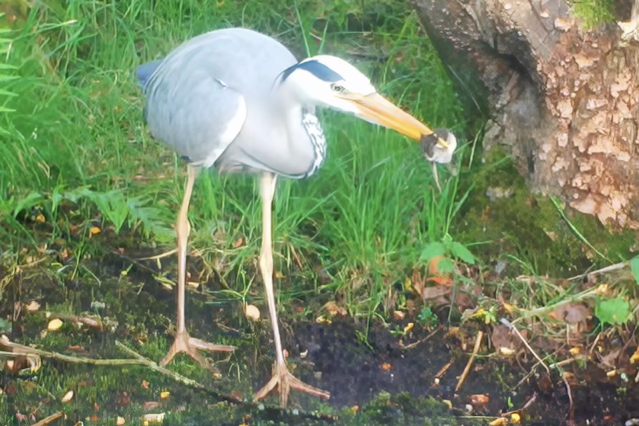I have a new waterside trail camera position, taking advantage of a newly fallen branch, the only drawback being that I now need waders to reach the camera. Having cameras watching the water's edge occasionally throws up a real surprise, as with this one. I haven't had good video of a heron before, mainly because they are so close to the cameras that they don't fit in the frame.
My Blog List
Saturday, 29 June 2024
The ending of the shrew
I have a new waterside trail camera position, taking advantage of a newly fallen branch, the only drawback being that I now need waders to reach the camera. Having cameras watching the water's edge occasionally throws up a real surprise, as with this one. I haven't had good video of a heron before, mainly because they are so close to the cameras that they don't fit in the frame.
Saturday, 22 June 2024
The weasel has a takeaway
My previous attempts at filming a weasel collecting food were thwarted by its high speed smash-and-grab technique - all we could see was a blur as it departed. This time I had two mice and I thought if I put them both out the weasel might be spoilt for choice. And it worked.
The mice were fresh and only four hours after I put them in the camera box a male weasel turned up. As you will see in the video, he was very undecided but eventually took one mouse away. He was back very early next morning and brought the rather chewed mouse with him. He obviously knew the second mouse was there but left again with the first one.
Four hours later he was back and took the second mouse, seeming to play fight with it before he left. Another two hours later he returned, apparently without the mouse, but I think it was just outside because after another minute he threw it back in, just as an ambulance went by. After checking to see whether it was an ambulance or a police car he returned for his prize and left.
I knew weasels were in the habit of carrying their food around but it is fascinating to see it. Because of their small size, body shape and hyperactive lifestyle weasels need to eat one third of their body weight in a day, roughly one mouse a day. If they are able to catch more than this they will cache food for later, presumably not bothered if it is a bit ripe.
Friday, 14 June 2024
Ten years of blogging
I'm not one for birthdays or anniversaries or big round numbers but I did notice that today it is 10 years since my first post on this blog. That was on great spotted woodpeckers feeding their young, a subject that has been repeated several times at this time of year. To come full circle the young woodpeckers have once again appeared outside my kitchen window this week so here are a couple of photos taken through the kitchen window yesterday.
In the last ten years there have been over 1500 posts on this blog but it isn't possible to say how many views or readers. In 2017 the blog was targeted by French spambots and something similar has been happening over the past year, although this time I can't tell the source. Blogger removes all the spam so I never see it, but strangely it still counts all the "views". The real readership is about 2500 views a month so it is probable that there have been about 300,000 real views rather than the 425,000+ that Blogger lists. Still quite a big number. I hope I'll be able to complete another 10 years, probably always with woodpeckers in the second week of June.
Saturday, 8 June 2024
Daylight robbery
I have seen bumblebees robbing nectar from comfrey flowers before but as far as I remember I haven't seen this behaviour from solitary bees. Nectar robbing is when a bee takes nectar from the flower through a hole bitten in the side rather than entering normally and offering pollination, especially a bee with a tongue too short to reach the nectary. I suspect the holes were made by bumblebees and the others were just taking advantage. This is a Buff-tailed Bumblebee
and an Early Bumblebee.
A Common Carder Bee was doing it properly.
This was earlier in the week on the comfrey in the corner of the kitchen garden. The most numerous bees were male red mason bees.
They were also patrolling the flowers in the vain hope of finding a new female. In reality all the females are busy provisioning their nests and the males don't have long to live but that didn't stop them challenging and knocking each other off the flowers.
Female red masons were also robbing, obviously getting just nectar here and collecting their pollen elsewhere.
The most surprising to me was a nomad bee, a cuckoo that lays its eggs in solitary bees nests (usually mining bees).
It all goes to show that sometimes crime does pay. You can read more about the biology of nectar robbing here.
Monday, 3 June 2024
First moths of the year
This was the first time I have set up the moth trap this year. Previously it has been in the corner of the walled flower garden, just over the wall from the golf course. This time it was 50m away, at the edge of the meadow and close to the copse, so a slightly different environment.


























